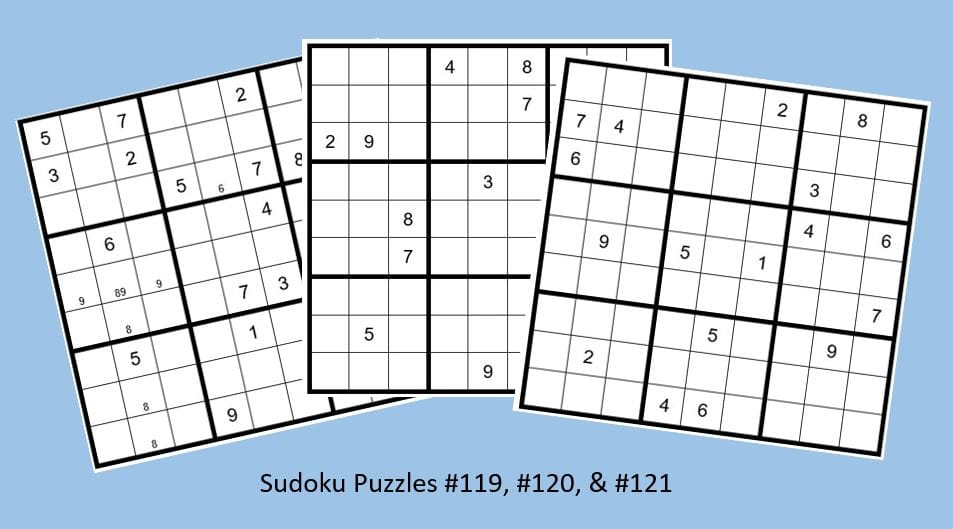Sudoku Puzzles 119, 120 & 121
by: Dan LeKander
We continue with 3 puzzles each month. Something for everyone!
Clueless?
We start with a Sudoku puzzle in progress, where it appears that there are no more obvious or not-so-obvious clues. Can you find the hidden clue in Puzzle #119?
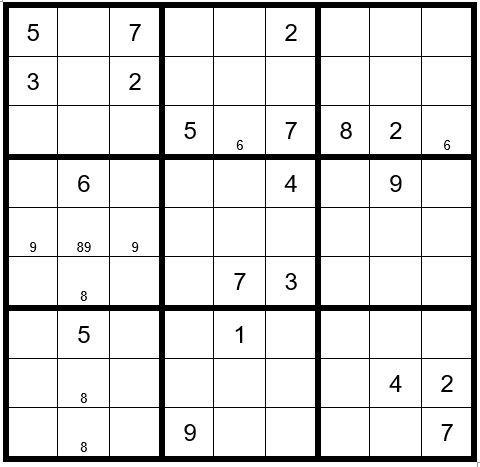
(The answer follows the conclusion of Puzzle #121, the feature puzzle for September)
Logic Puzzle
Difficult rating … 5/10
(Rating based on puzzles not requiring advanced techniques)
Puzzle #120 should present a moderate challenge!
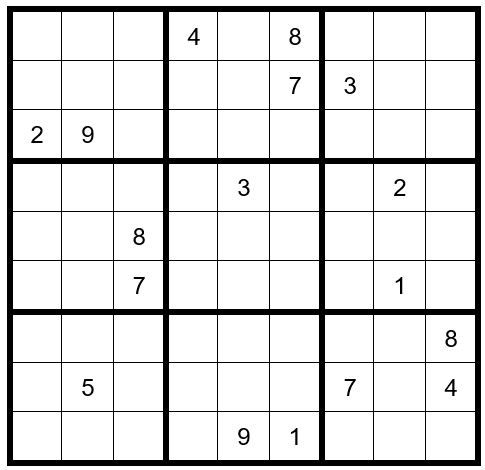
Feature Puzzle
Difficult rating … 7/10
(Rating based on puzzles requiring advanced techniques)
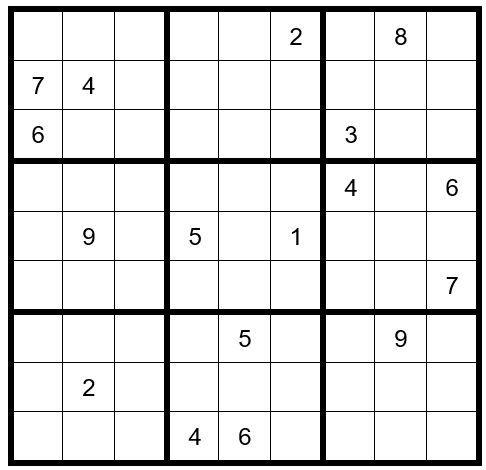
PUZZLE PREPARATION
Prior to utilizing techniques 1-8, complete the 5 Steps of Puzzle Preparation …
- FILL IN DATA FROM OBSERVATIONS
- FILL IN OBVIOUS ANSWERS
- FILL IN NOT-SO-OBVIOUS ANSWERS
- MARK UNSOLVED CELLS WITH OPTIONS THAT CANNOT EXIST IN THOSE CELLS
- FILL IN THE OPTIONS FOR THE UNSOLVED CELLS
The first thing we observe is that C4R7=2 & C7R6=9.
The only unsolved cell in row 5 that could be a 6 is C3R5. C3R5=6. Then, C2R7=6.
The only unsolved cell in row 5 that could be a 7 is C5R5. C5R5=7. Then, C1R5=4.
In column 6, C6R4, C6R7, C6R8 & C6R9 can only have options 3, 7, 8 & 9. This leaves C6R2, C6R3 & C6R6 limited to options 4, 5 & 6.
C8R4 & C8R6 have options 1 & 5. C7R4, C7R5 & C7R6 can only have options 2, 3 & 8.
In row 1 C4R1 & C7R1 can only have options 6 & 7.
In box eight, a 1 can only exist as an option in C4R8 & C5R8; therefore, a 1 cannot exist as an option in C1R8, C3R8, C7R8, C8R8 & C9R8.
In box one, a 2 can only exist as an option in C3R2 & C3R3; therefore, a 2 cannot exist as an option in C3R4 & C3R6.
Now your grid should look like Example #121.1 below:

This completes Puzzle Preparation Steps 1-4. Next, we will fill in options for all unsolved cells, giving us Example #121.2 below:
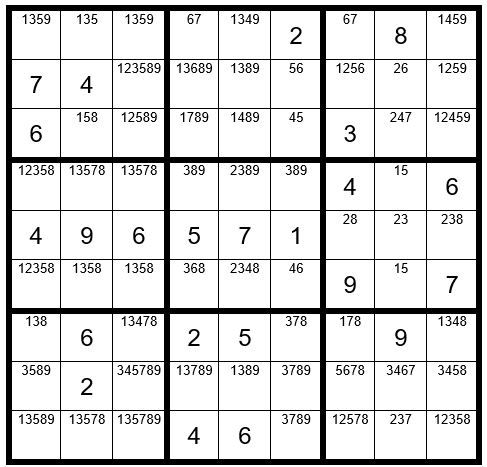
Dan recommends the following Steps to complete the puzzle.
Step 1: Sudoku Pairs, Triplets and Quads – See September 2015
Step 2: Turbos & Interaction – See October 2015
Step 3: Sudoku Gordonian Rectangles and Polygons – See November 2015
Step 4: XY-Wings & XYZ Wings – See December 2015
Step 5: X-Wings – See January 2016
Step 6: DAN’S YES/NO CHALLENGE
Step 7: DAN’S CLOSE RELATIONSHIP CHALLENGE
Step 8: AN EXPANSION OF STEP 7. Steps 1-5 are relatively common techniques and are explained in the TI LIFE articles. Steps 6-8 are covered in detail, in Dan’s book.

There are no Step 1-5 techniques that can be further applied. Are there are any good Step 6 potentials. As in previous articles, we determined a particular number was a potential for a successful Step 6 exercise if that number appears as a given answer in 3 separate boxes, such that the boxes are not side-by-side, nor over each other. Which numbers do you see that are good candidates? Yes, the 7’s, however the Step 6 exercise does not produce any clues, so we will move on to Step 7, Dan’s Close Relationship Challenge.
We will pick C6R2 as our starter cell, with a sequence of 5,6. We will annotate this on the 2nd level of this cell, as per Example #121.3 below:
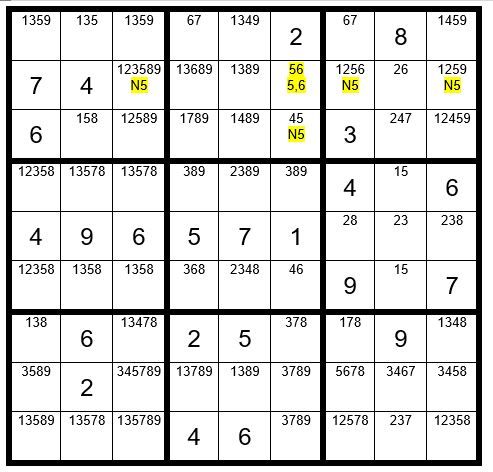
So, why did I pick as a starter cell C6R2 with a sequence 5,6?
By selecting C6R2 with the sequence 5,6, we would have immediate answers for C6R6 &C6R3, C4R1,as well as C8R2. This almost guarantees that the 6 will track through the puzzle far enough to give us positive results.
We annotate C3R2, C6R3, C7R2 & C9R2 with N5 indicating that those cells cannot be a 5 if the starting cell is a 5. As we track the 6 through the puzzle, if any of these cells is a value other than 5, it would indicate that this cell is not a 5 regardless if the starter cell is a 5 or 6, and the 5 could be deleted as an option for that cell.
Before we perform this exercise, we will list the potential outcomes …
• The tracking of the second number of the starter cell doesn’t reach the N9 cells, and therefore, the exercise is unsuccessful.
• The tracking of the second number goes entirely through the puzzle without a conflict, indicating that the 2nd number is correct for the starter cell and you have solved the puzzle.
• The tracking of the second number creates a conflict, such as a number showing up twice in a row, column or box. Or it could show up by having no cell for a particular number in a row, column or box. Regardless of how the conflict arises, it would mean the second number is incorrect for that cell, and therefore, the answer to the starter cell is the first number.

We will now track the 6 through the puzzle above on the third level of the unsolved cells to preserve the integrity of the original puzzle.
As you can see from the example above, in tracking the 6 through the puzzle, we have two 2’s in column 8. This is a conflict! Therefore, C6R2 cannot be a 6. We have now determined that C6R2=5.
The puzzle is easily solved from this point, giving us Example #121.5 below:
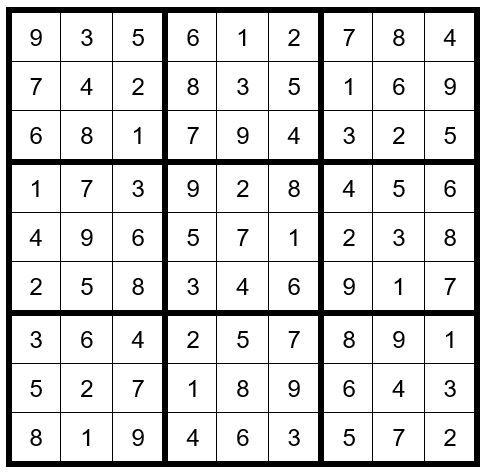
May the gentle winds of Sudoku be at your back.
Dan LeKander
Clue for Puzzle #119 … did you find the clue? If not, read on.
• Check row 7. What do you see?
• We see that C1R7 & C4R7 have options 2 & 7. Then, C3R7=4. You may want to continue and see if you can solve the puzzle!


